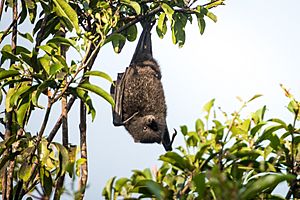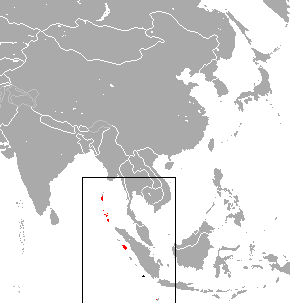Black-eared flying fox facts for kids
Quick facts for kids Black-eared flying fox |
|
|---|---|
 |
|
| Conservation status | |
| Scientific classification | |
| Genus: |
Pteropus
|
| Species: |
melanotus
|
 |
|
| Black-eared flying fox range: extant extinct | |
| Synonyms | |
|
Pteropus edulis |
|
The black-eared flying fox is a type of large bat. Its scientific name is Pteropus melanotus. People also call it Blyth's flying fox.
These bats live on islands in India and Indonesia. You can find them on the Andaman Islands, Nicobar Islands, and in Sumatra. A similar bat, the Christmas Island fruit-bat, used to be thought of as the same species. But scientists now know it is a different kind of bat.
Where Do They Live?
The black-eared flying fox lives on many islands in the Indo-Pacific region. This includes the Andaman Islands, Nicobar Islands, and Mentawai Islands.
They usually live in large groups called colonies. These colonies often make their homes in forests near the coast. They especially like areas with mangrove trees.
What Do They Eat?
Most bats are active at night, but the black-eared flying fox is different. It is more diurnal, which means it is active during the day. These bats leave their roosts (their resting places) before the sun goes down.
They eat fruits and flowers from many different trees. They feed on at least 26 kinds of forest trees. Some of these trees were brought to the islands by people.
Family Life
Female black-eared flying foxes usually give birth to one baby each year. This helps new bats join the colony.
Are They in Danger?
The black-eared flying fox faces several challenges. One big problem is that their forest homes are being destroyed. This means fewer places for them to live and roost.
People also hunt these bats for food. Sometimes, their crushed bones are used in traditional medicine. This medicine is thought to help with asthma.
However, these bats are good at changing their diet. They have learned to eat fruits and flowers from new types of plants. These plants were brought to their islands by humans.
The IUCN (International Union for Conservation of Nature) has listed this species as "Vulnerable". This means they need protection to help their numbers grow.


